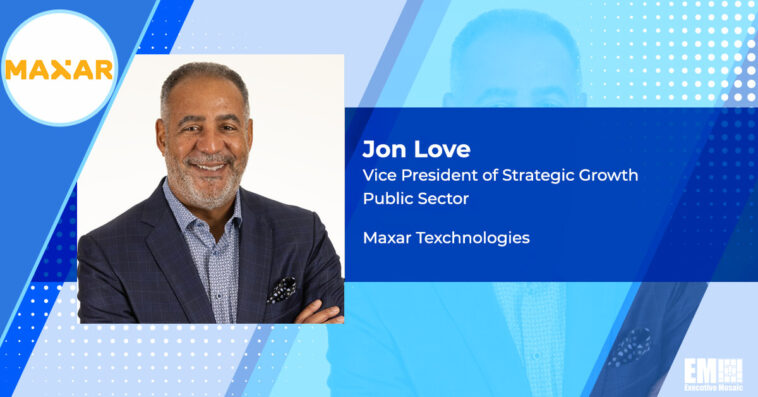Since his time as president of Pitney Bowes’ government solutions arm in the 2000s, Jon Love has been deeply involved in capturing technology business in the public sector. Love subsequently built on this experience with positions of increasing responsibility at General Dynamics Information Technology and Microsoft, before joining Maxar Technologies in 2020.
Today, as Maxar’s public sector vice president of strategic growth, Love leads a team that is expanding the company’s market reach in the U.S. government and among its allied international partners. His unit oversees business development, capture, technology strategy, partner development and fostering executive engagement.
In this Executive Spotlight conversation, Love discussed important recent contract wins for Maxar, went in-depth on the company’s Earth intelligence and Earth observation tools and strategies and more.
What can you tell us about the company’s recent growth initiatives and how you’re driving value for your customers?
Maxar goes to market in two primary business segments. First is our space infrastructure business, the part that manufactures spacecraft and robotics. From a growth perspective, we recently announced we’re participating on the Space Domain Awareness Tranche 1 Tracking Layer contract. We’re going to build 14 spacecraft platforms as a subcontractor to L3Harris, who is the prime contractor. So, working closely with L3Harris and Space Development Agency on those capabilities is going to be a nice lift for us from a growth perspective. That constellation will be proliferated low-Earth orbit satellites that track and detect missile threats, and positions the company to produce more pLEO satellites for both commercial and defense applications.
The other part of our business is our earth intelligence business segment, where we do quite a bit of business with agencies like the National Reconnaissance Office and the National Geospatial-Intelligence Agency, along with the commercial marketplace where more and more of those customers are interested in our ability to take clear pictures of the Earth, make sense of the data and help them understand and infer what’s going to happen next.
From a government market perspective, we had a couple of notable wins this year. We won a NRO contract for the Electro-Optical Commercial Layer, which has a five-year base with five additional option years through 2032. It’s the largest commercial imagery acquisition contract that the NRO has ever awarded. Under that award, Maxar will provide high-resolution commercial imagery in support of defense and intelligence community missions for both the U.S. military as well as allied partners.
The other one that’s given us lift is our continuing work with the NGA, where we were recently awarded a third option year for the Global Enhanced GEOINT Delivery Program. Under Global-EGD, we provide data, imagery and information in an unclassified environment to about 400,000 people in the U.S. government every day.
Those awards have been key to our growth strategy, and we’ll continue to move out in that direction. Beyond just contract awards, we’re continuing to build out capabilities that are complementary to Earth observation.
Our acquisition of Vricon a few years ago allowed us to begin to build the entire globe in 3D, which is becoming a fast-evolving technology that’s super interesting to a lot of our customers who really need to be able to see and experience the world, especially in a disconnected environment. Whether you’re flying a drone or an airplane or driving a tank or Humvee in an area where GPS doesn’t do the job because it’s not working or it’s disconnected, our Precision3D capability will allow you to see what’s out there with an accurate depiction of what’s on the ground. We’re counting on that being a huge source of lift and opportunity for us and our customers across the spectrum for quite a while.
With the influence of emerging technologies impacting every aspect of business, how has your company been able to drive digital transformation efforts to stay ahead of innovation in the federal landscape for yourself and your customers?
In terms of digital transformation and some of the technology that’s evolving out there, I think there are two major things that are complementary right now. One is the advent of the cloud. We are being very intentional about placing technology in the cloud, not because we just want to migrate from on-prem to a data center, but because we see the promise of the cloud, the technology in the cloud and what it brings—things like hyperscale compute and greater capacity and capability. The ability to access these super computers to crunch data much quicker is very important. I think that’s a strong enabling technology.
Beyond that, edge computing and being able to process data in space, in theater or close to where the action is taking place is really going to be a game-changer. Key to this is reducing the time it takes to collect data and get it in the hands of the warfighter or decision-maker. We’re also complementing that collection capability with tools and resources, using artificial intelligence and machine learning to not only see what’s there, but identify what it means and sort through it quickly to be able to come to conclusions so that people can make decisions. We call that process ‘sensor-to-decision’.
In this competitive environment, what are some key differentiators that help Maxar stand out as federal customers consider geospatial intelligence partners?
We are trying to understand exactly what the U.S. and its allies’ mission needs are and how we can provide them with the best situational awareness so that as they advance their technology and their tools, we are alongside them. We work with them on various exercises, including efforts related to shortening the sensor-to-decision timeline and creating content and insights that are easily consumable and easily shareable.
One of the things that we offer for our customers that’s been pretty hot lately is our Crow’s Nest Maritime Monitoring Solution. It allows us to observe the seas and to tell a customer, regardless of whether it’s day or night, what ships are doing out there, where they’re going and if something nefarious is going on. Is there illegal fishing happening? Perhaps a group is offloading oil from tankers in the middle of the night with their automatic identification systems turned off; that could be a sign of illegal activity. Customers are interested in that kind of insight. You don’t necessarily collect that with just an electro-optical sensor. You collect it with a host of coordinated sensors and technologies.
The way that Crow’s Nest uses coordinated sensors and technologies touches on another industry trend, which is the proliferation of the different types of data that’s being collected. We talked about electro-optical, but we’re also multisource. There’s synthetic aperture radar that’s being collected. There’s radio frequency, there’s hyperspectral; there are different types of data being collected by these satellite sensors across the world and each of them have unique applications.
For example, an electro-optical satellite without shortwave infrared capabilities may not be able to collect adequate data in a region obscured by wildfires, but when you start incorporating SWIR—like on Maxar’s WorldView-3 satellite—SAR, RF or other hyperspectral capabilities, you can see through the smoke and still be able to flag information that’s really important to people who are making life-or-death decisions on the ground. I’m excited to see that companies are building and launching these other types of sensors. We’re partnering with a lot of these companies today. It’s going to give our customers a new set of insight so they can make choices and faster decisions.
What are your strategic goals for the coming year? What do you hope to accomplish and any new markets that you’re keeping an eye on in the federal sector?
I’ll single out two things. We are really excited about the possibilities when it comes to building the globe in 3D and being able to provide that Precision3D terrain data. We can provide the foundational layer for the entire Earth and offer an accurate, reliable, trusted data source. With these capabilities, we’ll be able to show the Earth in great detail, at a very high-resolution level as you get closer to the ground. So, whether you are flying a plane or a drone, or a driving a tank in the real world, you need the coordinate accuracy that 3D provides to make sure that you know exactly where to land or maneuver and you can have confidence that that data is correct. We provide that georegistration of imagery through a product called Precision3D Registration.
You need a true representation of the Earth, not only to reflect the terrain in all dimensions, but also lay down an accurate foundation for additional data sources that you may want to overlay. We’re super excited about that capability.
Finally, from an electro-optical perspective, we’re adding new satellites to the Maxar constellation next year. Once the six WorldView Legion satellites join our current satellites, we will have the ability to revisit areas of the Earth up to 15 times a day, with a very high-resolution. For those who are interested in monitoring conditions, detecting change and understanding what’s going on around the planet, this new capability is going to be incredibly important, and we think it’s going to really be a lift for our business in the future.
William McCormick contributed additional reporting





